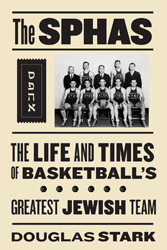Earlier this week, Douglas Stark wrote about the best Jewish basketball team ever and about researching Jewish sports. He has been blogging all week for the Jewish Book Council and MyJewishLearning‘s Visiting Scribe.
 To me, history is telling stories about people. I have always been fascinated by people’s lives, the decisions they make (or don’t), and ultimately what happens to them. One of my objectives in writing The SPHAS was to have an opportunity to tell the stories of the players and, in some cases, the fans who attended the games. Who were the SPHAS? Where did they come from? Why were they attracted to basketball? Who were they as people?
To me, history is telling stories about people. I have always been fascinated by people’s lives, the decisions they make (or don’t), and ultimately what happens to them. One of my objectives in writing The SPHAS was to have an opportunity to tell the stories of the players and, in some cases, the fans who attended the games. Who were the SPHAS? Where did they come from? Why were they attracted to basketball? Who were they as people?
As I crafted the book, I decided that I would try and tell the story of each season through one or two players. This allowed me to combine the stories of the players with the game-by-game story and drama of each season. It also proved a fairly easy way to organize the book.
One of the challenges of writing a book about a defunct basketball team whose heyday was in the 1930s and early 1940s was that most of the players had either passed away or were very old. I had two paths to take. One was to interview family members of the players from the 1930s. The second was to speak with players who played in the 1940s. Both proved invaluable.
The family members of the 1930s players were able to provide information about who the players were as people and about their childhoods. But in many instances, they were unable to talk about the playing days. Some were too young to remember. Some maybe never asked. However, many of them had scrapbooks of articles and these proved to be a tremendous source of information. Athletes from a certain generation actively kept scrapbooks chronicling their careers. The articles, programs, and ticket stubs contain valuable information. Athletes today do not seem to have the same desire in maintaining scrapbooks.
I was also able to interview quite a few players from the 1940s, and, although they might forget some information, they all loved talking about their playing days. Their faces light up and they can recall a game 70 years ago better than what they had for dinner last week. As they talked, they were young again, playing basketball, traveling 5 or 6 in a car from one town to another, and growing the game.
They all had interesting stories to tell and seemed grateful that someone today wanted to hear their stories. It was my honor to tell their stories and I hope that I did it well.
Douglas Stark’s The SPHAS: The Life and Times of Basketball’s Greatest Jewish Team, is now available.
Douglas Stark is a sports historian who has worked at the Naismith Memorial Basketball Hall of Fame, the United States Golf Association, and now as the Museum Director at the International Tennis Hall of Fame, where he oversees the day-to-day operations of the museum. He is the author of The SPHAS: The Life and Times of Basketball’s Greatest Jewish Team and Wartime Basketball: The Emergence of the National Sport during World War II.
Douglas Stark is available to be booked for speaking engagements through Read On. Click here for more information.


